Howden, East Riding of Yorkshire
Up to 1834
From 1665-1794, a site on Pinfold Street in Howden was used as a lodging house for the needy. A workhouse was then opened on the site which included a manufactory, stone-breaking yard, cowshed, and prison. A parliamentary report of 1776 listed the parish workhouse at Howden as being able to accommodate up to 20 inmates.
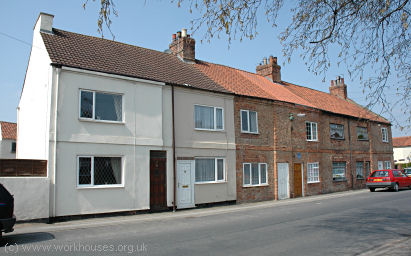
Howden town workhouse, 2005.
© Peter Higginbotham.
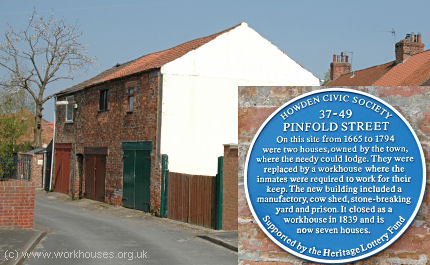
Howden town workhouse, 2005.
© Peter Higginbotham.
The former Holme-on-Spalding-Moor workhouse, now Workhouse Farm, dates from around 1790.
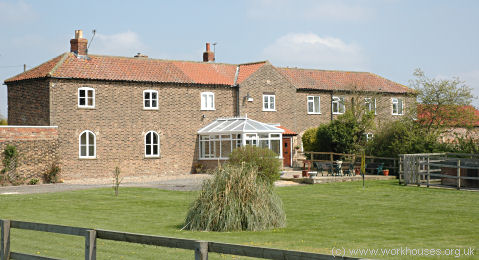
Workhouse Farm, Holme-on-Spalding-Moor, 2005.
© Peter Higginbotham.
The establishment also had two small circular "lock-ups", one for men and one for women — the latter still survives.
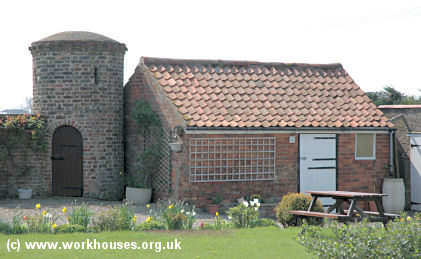
Workhouse Farm women's lock-up, Holme-on-Spalding-Moor, 2005.
© Peter Higginbotham.
According to the 1854 map (below) Breighton had a group of "Poor's Houses" opposite the beginning of Ferry Lane.
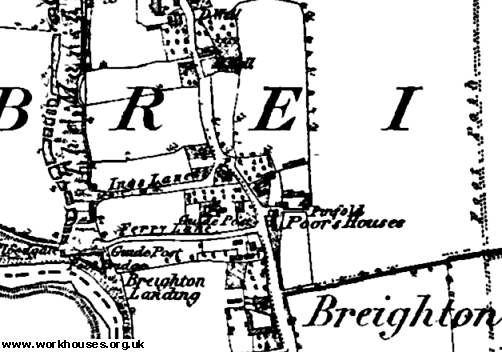
Breighton Poor's Houses site, 1854.
There was a similar establishment at the west side of Newsholme, where Newsholme Farm now stands.
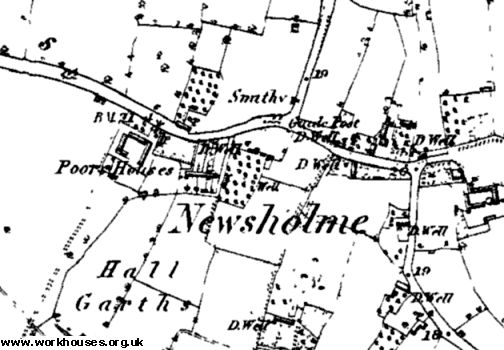
Newsholme Poor's Houses site, 1854.
A local workhouse also operated at Cave.
After 1834
Howden Poor Law Union was formed on 4th February 1837. Its operation was overseen by an elected Board of Guardians, 42 in number, representing its 40 constituent parishes as listed below (figures in brackets indicate numbers of Guardians if more than one):
East Riding: Asselby, Aughton, Backenholme with Woodale, Balkholme, Barmby-on-the-Marsh, Belby, Bellasize, Blacktoft, Breighton, Broomfleet, Bubwith, North Cave with Drewton Everthorpe, Cheapsides, Cotness, Eastrington, Elberton Priory, Flaxfleet, Foggathorpe, Gilberdike, Gribthorpe, Harlthorpe, Hemingbrough, Holme upon Spalding Moor, Hotham, Howden (2), Kilpin, Knedlington, Latham, Loxton, Metham, Newport Wallingfen, New Village, Newsham & Brind and Wressal & Loftsome, Portington & Cavil, Saltmarsh, Scalby, Skelton, Spaldington, Thorpe, Willitoft, Yokefleet.
The population falling within the union at the 1831 census had been 12,728 with parishes ranging in size from Cotness (population 29) to Howden itself (2,130). The average annual poor-rate expenditure for the period 1834-6 had been £6,263.
Initially, the Howden Guardians declined to build a new workhouse but made use of the existing parish workhouses in Howden, Holme and Cave. However, in 1839, following persuasion by the region's Assistant Poor Law Commsissioner John Revans, a new building was erected on the south side of Knedlington Road. It was designed by Weightman and Hadfield of Sheffield. The site location and layout are shown on the 1907 map below.
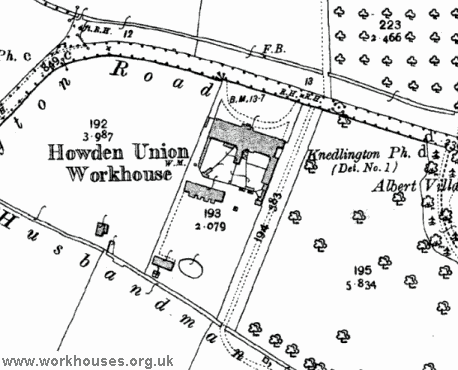
Howden workhouse site, 1907.
The main block was a deep oblong structure, possibly with rooms running either side of a central corridor. A short central wing at the rear divided the male and female sides, with observation windows placed in the angled corners. A separate block, probably an infirmary, was subsequently added at the south of the main block.
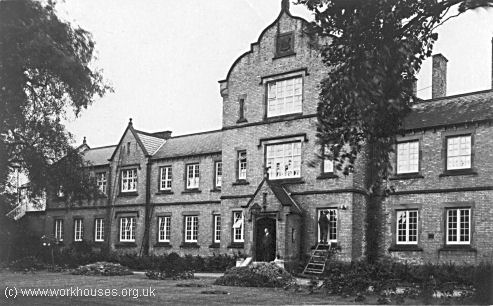
Howden union workhouse, c.1925.
© Peter Higginbotham.
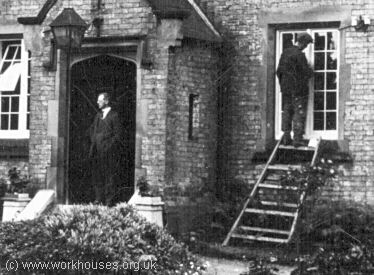
Howden union workhouse detail, c.1925.
© Peter Higginbotham.
In January, 1867, the workhouse received a visit from Poor Law Board Inspector Mr HB Farnall. His report included the following comments:
The site of the house is suitable, and the area sufficiently ample to enable the Guardians to add to the buildings when requisite.
The accommodation for the several classes is generally sufficient; but there are several defects in the accommodation. The dining hall, the kitchen, the scullery, and the aged women's day-room are too small; the nursery also is a defective ward, its floor is of stone, and there is no watercloset annexed to it. All the privies in the yards are over cesspools, and they cannot be flushed. There are no bath rooms in the house. The lavatories for boys and girls are extremely defective ; and the boys' and girls' day rooms are also defective; these latter rooms might be converted into good lavatories.
Provision is made for separating the infectious cases from the other sick inmates; but this provision is defective. It consists of a detached building containing four rooms, but there are no watetclosets attached to it, nor is there a room for a nurse, and the floors of the two lower rooms are of brick. These two lower rooms are dedicated to vagrants.
Separate sick wards are not, strictly speaking, provided for children; but a room in the sick wards is set apart for them.
The ventilation and light are generally good, but the water supply, which consists of rain water for drinking purposes, and of water from a pump for domestic purposes, is not always complete, for sometimes rain water has to be purchased fur the use of the inmates in summer time.
The beds are good, but some of them are too hard; the bedding is sufficient, but the conveniences for washing are insufficient.
The classification, diet, clothing, and employment of the inmates is sufficient; but the means of recreation is not sufficient, there being no books of an amusing and instructive character for the aged and infirm.
The medical officer finds all drugs. A resident medical officer is unnecessary.There is no paid nurse.
All the inmates, who can be trusted, go out to church and chapel ; and the ministers of those inmates who are not in communion with the Church of England are permitted to visit the workhouse. The school is within the workhouse, and the children are separated from the adults. There is no entrance to the school-room from the body of the house, so that the children, many of whom are very young, must go out of the house to enter the school-room.
After 1930, the workhouse later became Howden Public Assistance Institution, and then Howden Hospital. It finally closed in 1947 and was later demolished.
Staff
Inmates
Records
Note: many repositories impose a closure period of up to 100 years for records identifying individuals. Before travelling a long distance, always check that the records you want to consult will be available.
- East Riding of Yorkshire Archives and Local Studies, The Treasure House, Champney Road, Beverley HU17 9BA . Holdings include: Guardians' minute books (1837-1930 with gaps); Births and deaths (1914-48); etc.
Bibliography
Links
Unless otherwise indicated, this page () is copyright Peter Higginbotham. Contents may not be reproduced without permission.


